
Shopping can feel like a harmless way to lift your mood. After a stressful day or emotional setback, a new purchase can bring a quick rush of excitement and control. This momentary relief is why retail therapy has become so common in our fast-paced, consumer-driven world. However, what begins as a quick fix often turns into a lasting burden. Emotional spending can quietly deepen anxiety, financial stress, and emotional exhaustion.
For individuals in addiction recovery or dealing with mental health challenges, this pattern can be especially harmful. Retail therapy may seem like self-care, but it often masks unresolved feelings that need attention. Understanding how shopping and anxiety are connected is key to finding healthier, more sustainable ways to manage emotions and build lasting well-being.
The Temporary High of Retail Therapy
When you make a purchase, the brain releases dopamine, the “feel-good” chemical associated with reward and pleasure. This surge can temporarily relieve feelings of sadness, stress, or loneliness. For a short time, shopping provides distraction and comfort.
But the effect is fleeting. Once the novelty fades, anxiety often returns—sometimes stronger than before. The empty feeling that follows leads many people to repeat the cycle, chasing the same sense of control and relief through more purchases. Over time, this can develop into a behavioral pattern that mirrors addiction, where shopping becomes a way to cope instead of confronting the real emotional issues underneath.
The Emotional Costs of Compulsive Shopping
1. Anxiety After the Purchase
That initial rush of happiness can quickly turn into worry about money, regret over impulsive choices, or guilt about unnecessary spending. This “buyer’s remorse” can feed a cycle of anxiety that becomes hard to escape.
2. Avoidance of Underlying Emotions
Retail therapy provides a temporary distraction but doesn’t resolve the emotional triggers that cause distress. By avoiding those feelings, anxiety can build quietly in the background, waiting to resurface.
3. Financial Stress and Emotional Overload
Debt and overspending can become powerful sources of chronic stress. When financial strain combines with guilt and emotional fatigue, anxiety can become overwhelming.
Why This Pattern Is Common in Recovery
For those recovering from addiction, the shift from one coping behavior to another is not unusual. Emotional spending can act as a substitute for the dopamine-driven habits of substance use. While it may seem safer, it still prevents emotional growth and self-awareness.
At its core, recovery is about learning to face discomfort with honesty and self-compassion. Identifying emotional spending as a form of avoidance allows individuals to build more constructive coping skills.
Healthier Alternatives to Retail Therapy
Practice Mindfulness and Emotional Awareness
Mindfulness teaches you to pause, reflect, and identify what you’re truly feeling before acting on impulse. Simple breathing exercises or journaling can help you understand emotional triggers and build healthier responses.
Engage in Physical Activity
Exercise releases endorphins and provides a natural, lasting boost in mood. Walking, yoga, or stretching can help manage anxiety without adding financial stress.
Connect with Support Systems
Isolation can intensify emotional cravings. Reaching out to friends, family, or recovery peers helps provide authentic connection and emotional balance.
Seek Professional Guidance
Inpatient and outpatient treatment programs, counseling, and holistic care offer structured support. Individualized and faith-based approaches can help uncover the root causes of emotional spending while building emotional resilience and financial awareness.
Breaking the Cycle and Finding Real Relief
Breaking free from emotional spending begins with awareness. When you recognize shopping as a coping mechanism, you can begin to make conscious choices that promote healing. Instead of searching for relief in material items, focus on activities that nurture your mind, body, and spirit.
Recovery and mental wellness require long-term care, patience, and compassion. With the right tools and professional guidance, it’s possible to replace impulsive behaviors with mindful practices that bring peace and purpose.
Choosing Lasting Peace Over Temporary Pleasure
Retail therapy may offer momentary relief, but the anxiety and stress it creates can become a lasting burden. By understanding the emotional connection between shopping and anxiety, individuals can make empowering choices that lead to true healing.
If you or someone you love struggles with emotional spending or other coping challenges, help is available. Reaching out to a trusted recovery program or mental health professional is the first step toward emotional balance and lasting peace. Healing begins when you choose to address the root of the problem, not just the symptom.